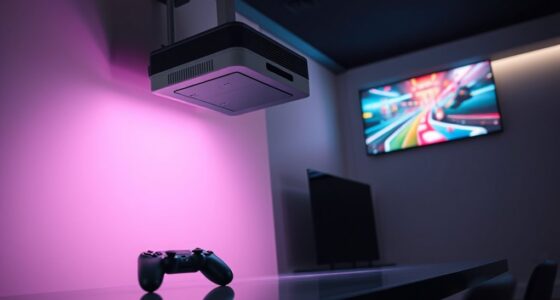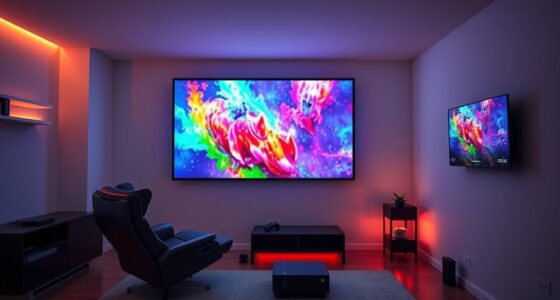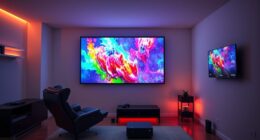Understanding 120Hz and VRR myths can boost your gaming and viewing experience. A 120Hz screen refreshes 120 times per second, delivering smoother motion, but it doesn’t eliminate all blur. VRR syncs your display’s refresh with your device’s frame rate, reducing tearing and stuttering—yet isn’t a magic fix for everything. Many misconceptions exist—like higher rates always being better—so exploring these facts will help you optimize your setup for peak performance.
Key Takeaways
- Higher refresh rates improve motion smoothness but do not eliminate all motion blur; they mainly enhance visual fluidity.
- VRR reduces screen tearing and stuttering without causing frame skipping, and often lowers input lag when properly implemented.
- Myths persist that higher refresh rates always benefit hardware; in reality, compatibility and content limitations can restrict advantages.
- Frame rate matters more than refresh rate alone; higher frame rates improve clarity, responsiveness, and reduce flickering.
- Proper calibration and matching game frame rate to the monitor’s refresh rate optimize VRR benefits and overall visual experience.
What Does 120Hz Actually Mean for Your Screen?

Understanding what 120Hz actually means for your screen is essential to grasp how it affects your viewing experience. At 120Hz, your display refreshes 120 times per second, resulting in smoother motion and reducing motion blur during fast-paced scenes. This higher refresh rate makes rapid movements appear clearer and less streaky, especially in gaming or action-packed videos. It can also influence space and organization by enabling more seamless visual transitions and reducing eye strain. However, it can also impact input lag—the delay between your action and what you see on the screen—potentially making responses feel less immediate if not properly optimized. While 120Hz provides a more fluid image, it’s important to remember that the real benefits depend on your device’s overall processing capabilities. Understanding these factors helps you choose a display that truly enhances your experience without sacrificing responsiveness.
Clearing Up the VRR Confusion: How It Works and Why It Matters
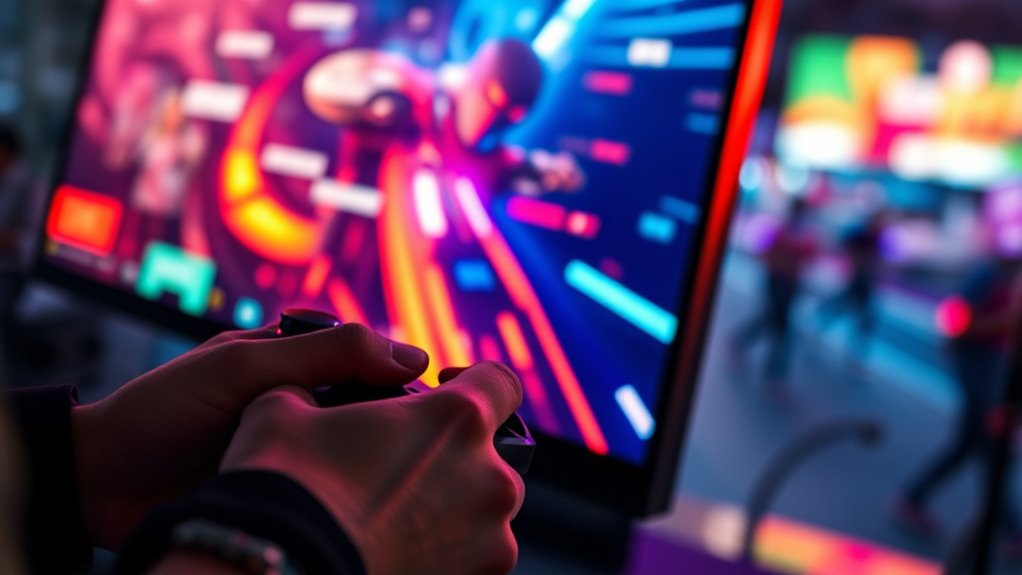
Variable Refresh Rate (VRR) is a technology that dynamically adjusts your display’s refresh rate to match the frame rate of your content, reducing screen tearing and stuttering. It makes gameplay smoother and more responsive, but it can sometimes cause motion smoothing or increase perceived input lag. Understanding how VRR works helps you optimize your experience. When VRR is active, your display syncs with the source device’s frame rate, minimizing tearing. However, it’s essential to know that motion smoothing might be unintentionally enabled, making fast movements look unnatural. Additionally, some users notice slight input lag changes. Here’s a quick overview:
| Aspect | Impact |
|---|---|
| Motion smoothing | Can cause unnatural motion |
| Input lag | Slight increase, often negligible |
| Frame matching | Reduces tearing and stuttering |
Recent updates in display technology continue to improve VRR’s effectiveness, making it more seamless for gamers and viewers alike.
Common Myths About Refresh Rates and VRR Debunked
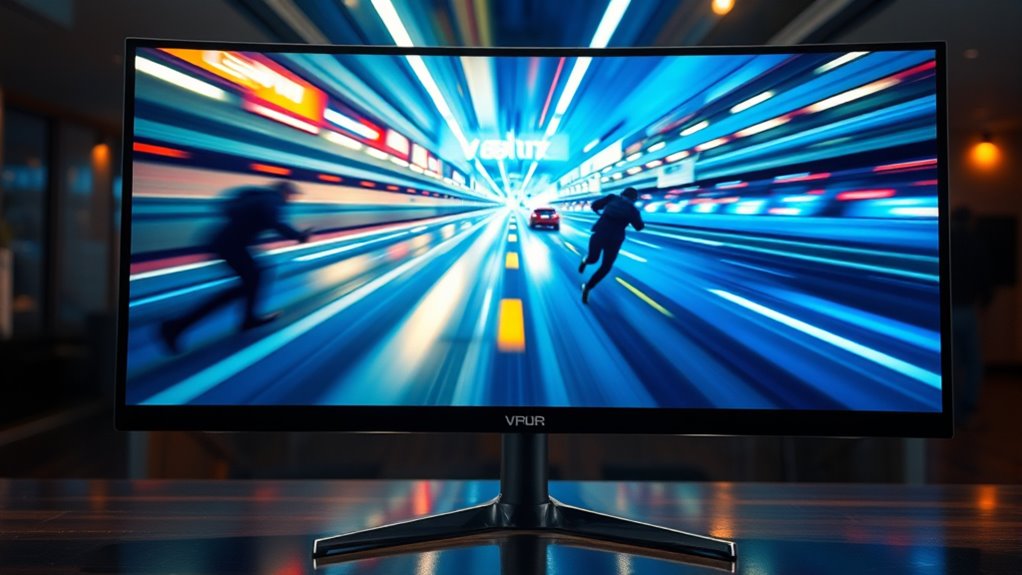
Many common beliefs about refresh rates and VRR are actually misconceptions. Some think higher refresh rates eliminate all motion blur, but that’s not true; they mainly smooth out the image. Others believe VRR causes frame skipping, but it actually reduces issues like stuttering and tearing without introducing significant frame skipping. A common myth is that VRR increases input latency, but in reality, it often lowers it by syncing the display with your GPU’s output. People also assume that higher refresh rates always mean better gaming, but if your hardware or content can’t match the rate, you won’t see much benefit. Additionally, understanding the different types of Gold IRA Rollovers can help you make more informed decisions about your investment options, especially when considering long-term financial security. Understanding these myths helps you make smarter choices about your display settings, ensuring you get the most out of your gaming experience without unnecessary concerns.
Why Frame Rate Matters More Than You Think
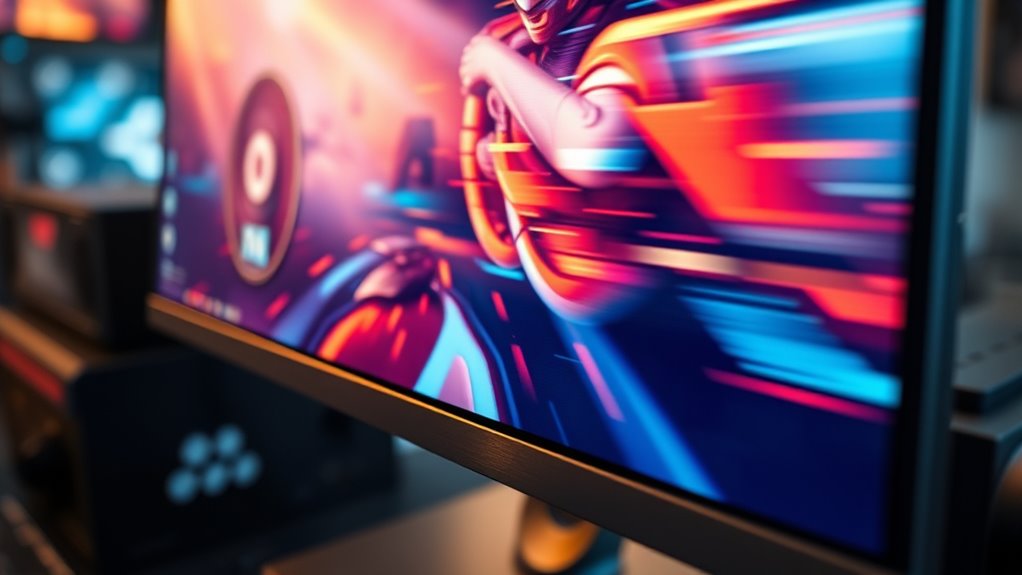
Frame rate directly impacts how smooth and responsive your gaming experience feels, often more than you realize. A higher frame rate reduces motion blur, making fast movements clearer and sharper, which is vital during intense gameplay. It also minimizes input lag, so your actions translate more quickly on screen, giving you a competitive edge. When frame rates drop, you might notice choppiness and delayed responses, which can ruin immersion and accuracy. Even with VRR, a low frame rate can cause flickering and tearing, undermining the benefits. Ultimately, a higher frame rate guarantees smoother visuals and quicker responsiveness, keeping you engaged and in control. Don’t overlook this key factor—your gameplay quality depends on it more than you might think. High refresh rates enhance overall visual fluidity, making every moment in your game more seamless.
Tips From Pros: How to Optimize Your Display Settings for the Best Experience
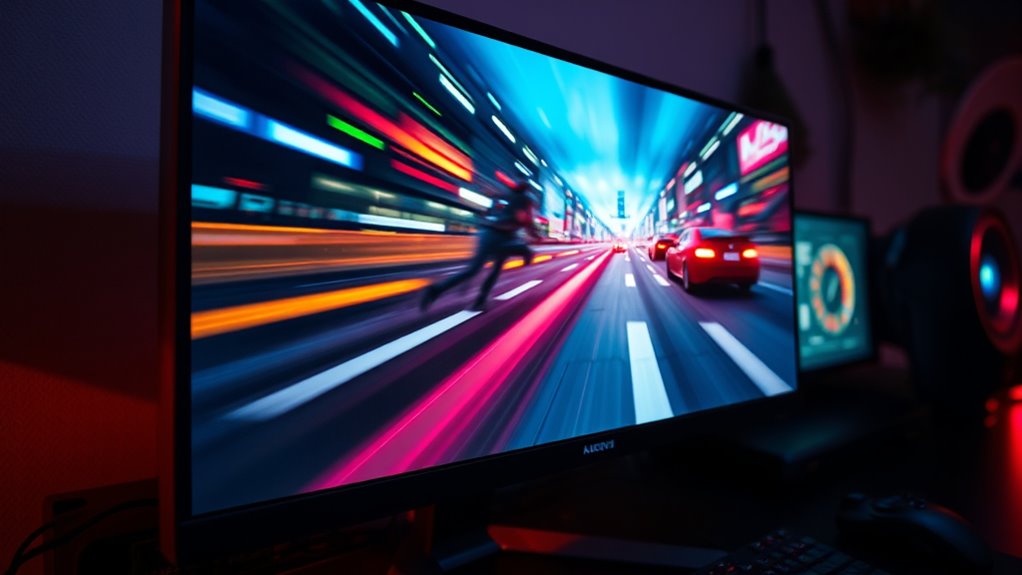
Optimizing your display settings can substantially enhance your gaming experience, and pros know the importance of fine-tuning for maximum performance. Start with calibration techniques to guarantee your display’s brightness, contrast, and color settings are accurate, providing clearer visuals and reduced eye strain. Adjust your monitor’s refresh rate to match your game’s frame rate for smoother gameplay. Pay attention to ambient lighting—avoid glare and reflections, and use dim lighting to reduce eye fatigue. Enable features like local dimming if available, and disable unnecessary image enhancements that can introduce input lag. Regularly recalibrate your display as lighting conditions change or after firmware updates. Considering display refresh rates can significantly impact your gaming smoothness. These small tweaks can make a significant difference, helping you enjoy games with ideal clarity, color accuracy, and responsiveness.
Frequently Asked Questions
How Does 120HZ Affect Gaming Latency and Input Delay?
With a 120Hz refresh rate, your gaming latency and input delay decrease because the display updates more frequently, providing smoother motion and reducing motion blur. This faster response time helps you react quicker, especially in fast-paced games. You’ll notice less lag between your actions and on-screen response, giving you a competitive edge. Overall, 120Hz makes gameplay feel more responsive, improving your experience by minimizing response time and enhancing input accuracy.
Can VRR Improve Performance on Non-Gaming Content?
Sure, VRR can jazz up your non-gaming content, but don’t expect miracles. It’s like adding whipped cream to a fruit salad—motion smoothing and frame interpolation might make videos look smoother, but they also risk creating that weird soap-opera effect. Still, if you crave buttery visuals on your favorite shows, VRR can help reduce tearing and stutter, giving you a more seamless viewing experience—just don’t expect it to turn your TV into a cinema.
Are Higher Refresh Rates Visible to the Average Viewer?
Yes, higher refresh rates are visible to you, especially in motion clarity and flicker perception. When you watch fast-moving scenes, you’ll notice smoother motion and less flicker, making the experience more comfortable and immersive. Your eyes can detect these differences, especially if you’re used to standard refresh rates. So, upgrading to a higher refresh rate display can markedly enhance your viewing, particularly during action-packed content or fast-paced videos.
What Are the Limitations of Current VRR Technology?
Imagine you’re gaming and notice some motion smoothing artifacts—that’s a limitation of current VRR tech. Hardware constraints, like processing power, can cause flickering or input lag during rapid scene changes. VRR can’t always perfectly sync with all games or content, leading to occasional tearing or stuttering. These issues highlight that while VRR improves visuals, it still faces challenges from hardware limits that impact smoothness and responsiveness.
How Do Different Devices Implement 120HZ and VRR?
Different devices implement 120Hz and VRR through varying hardware and firmware. You should check device compatibility since some TVs, monitors, and consoles support native 120Hz and VRR, while others require firmware updates to enable these features. Keep your device’s firmware current, as updates often improve VRR performance and fix bugs. Always verify compatibility before purchase to guarantee smooth gaming and viewing experiences with 120Hz and VRR technologies.
Conclusion
Understanding 120Hz and VRR can greatly improve your gaming and viewing experience. Did you know that gamers using high-refresh-rate screens report 30% smoother gameplay? By debunking myths and optimizing your settings, you can enjoy clearer visuals and reduced input lag. Don’t settle for less—embrace what pros recommend and realize your display’s full potential. Your screen is more powerful than you think, so make the most of it!


